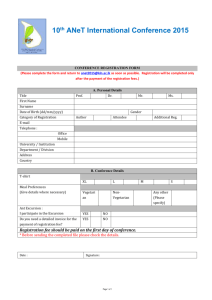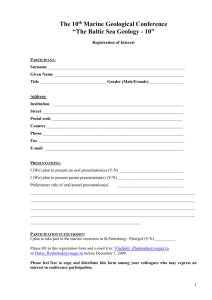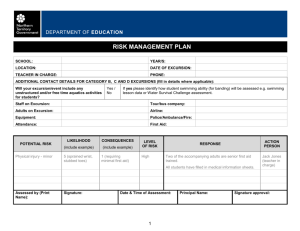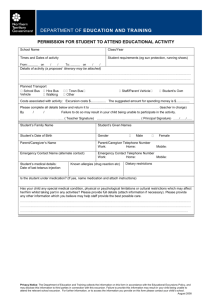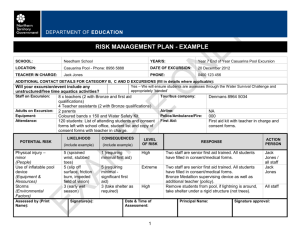Considerations for Normalizing Measures of the Star Excursion Balance Test
advertisement
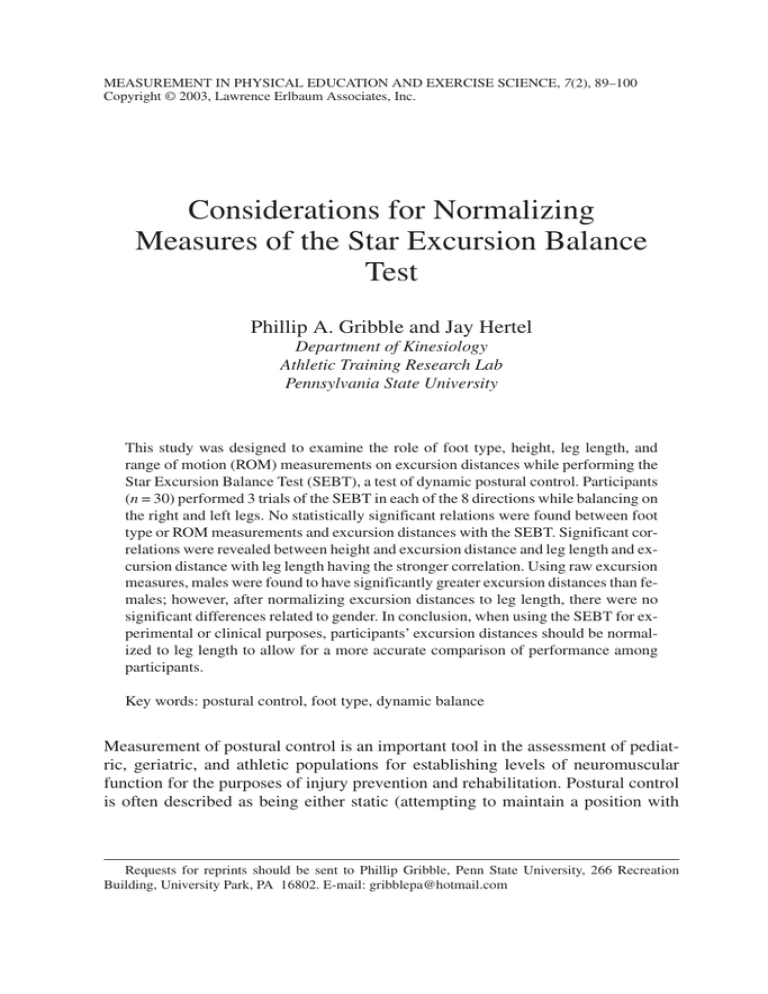
MEASUREMENT IN PHYSICAL EDUCATION AND EXERCISE SCIENCE, 7(2), 89–100 Copyright © 2003, Lawrence Erlbaum Associates, Inc. Considerations for Normalizing Measures of the Star Excursion Balance Test Phillip A. Gribble and Jay Hertel Department of Kinesiology Athletic Training Research Lab Pennsylvania State University This study was designed to examine the role of foot type, height, leg length, and range of motion (ROM) measurements on excursion distances while performing the Star Excursion Balance Test (SEBT), a test of dynamic postural control. Participants (n = 30) performed 3 trials of the SEBT in each of the 8 directions while balancing on the right and left legs. No statistically significant relations were found between foot type or ROM measurements and excursion distances with the SEBT. Significant correlations were revealed between height and excursion distance and leg length and excursion distance with leg length having the stronger correlation. Using raw excursion measures, males were found to have significantly greater excursion distances than females; however, after normalizing excursion distances to leg length, there were no significant differences related to gender. In conclusion, when using the SEBT for experimental or clinical purposes, participants’ excursion distances should be normalized to leg length to allow for a more accurate comparison of performance among participants. Key words: postural control, foot type, dynamic balance Measurement of postural control is an important tool in the assessment of pediatric, geriatric, and athletic populations for establishing levels of neuromuscular function for the purposes of injury prevention and rehabilitation. Postural control is often described as being either static (attempting to maintain a position with Requests for reprints should be sent to Phillip Gribble, Penn State University, 266 Recreation Building, University Park, PA 16802. E-mail: gribblepa@hotmail.com 90 GRIBBLE AND HERTEL minimal movement) or dynamic (maintaining a stable base of support while completing a prescribed movement; Winter, Patla, & Frank, 1990). Static postural control is commonly quantified through instrumented measurements of ground reaction forces or less sophisticated non-instrumented means. A clinician or researcher may assess static postural control by having an individual attempt to maintain a stationary position while standing on either one or both feet. Ground reaction forces may be measured by having a participant balance on a force plate. Postural control is then typically quantified through various measures of velocity, area, or variability of the ground reaction forces or a related variable (Guskiewicz & Perrin, 1996). Non-instrumented measures include variables such as time that a participant can maintain the prescribed stance (Freeman, Dean, & Hanham, 1965) or subjective error scoring systems (Riemann, Caggiano, & Lephart, 1999). A common clinical example of static postural control assessment is the modified Rhomberg test, first described by Freeman (Freeman et al., 1965). This test is performed by having participants stand as motionless as possible, on one foot, as a series of task demands are added to challenge the postural control system. These task demands include closing the eyes, tilting the head up, and touching an index finger to the nose. Although this test is commonly used in the assessment of cerebral concussion (bilateral stance) and lower extremity joint injuries (unilateral stance), it typically does not place strength or movement demands on the participant. Dynamic postural control often involves completion of a functional task without compromising one’s base of support. The advantage of assessing dynamic postural control is that additional demands of proprioception, range of motion (ROM), and strength are required along with the ability to remain upright and steady. Numerous tests have been developed to assess dynamic postural control in the pediatric (Donahoe, Turner, & Worrell, 1994) and geriatric (Berg et al., 1990; Rossiter-Fornoff, Wolf, Wolfson, & Buchner, 1995; Tinetti 1986) populations, but very few tests that truly stress the dynamic balance capabilities of the healthy, athletic population. The Star Excursion Balance Test (SEBT) is one such test that provides a significant challenge to an athlete’s postural control system (Earl & Hertel, 2001; Gray, 1995; Hertel, Miller, & Denegar, 2000; Kinzey & Armstrong, 1998; Miller, 2001; Olmsted, Carcia, Hertel, & Shultz, 2002). The SEBT involves having a participant maintain a base of support with one leg while maximally reaching in different directions with the opposite leg, without compromising the base of support of the stance leg. Strong intra-rater reliability of measurements with the SEBT has been demonstrated by Kinzey and Armstrong (1998) [ICC (2,1): 0.67–0.87)] and Hertel et al. (2000) [ICC (2,1): 0.81–0.96]. The SEBT has shown sensitivity in screening for functional deficits related to musculoskeletal injuries (Earl, 2002; Miller, 2001; Olmsted et al., 2002). In addition, Earl and Hertel (2001) demonstrated the usefulness of the SEBT for the re- NORMALIZATION CONSIDERATIONS OF THE SEBT 91 cruitment of lower extremity musculature contraction and discussed its application in rehabilitating various lower extremity musculoskeletal injuries. Researchers have provided evidence that the SEBT is sensitive for screening musculoskeletal impairments, such as chronic ankle instability (Olmsted et al., 2002), quadriceps strength deficits (Miller, 2001), and patellofemoral pain syndrome (Earl, 2002). Olmsted et al. reported decreased reaching distances during performance of the SEBT in patients with chronic ankle instability compared to matched-healthy control participants. Miller (2001) correlated quadriceps strength deficits with performance of the SEBT among subjects who had undergone anterior cruciate ligament reconstruction (ACLR). The ACLR subjects who demonstrated a quadriceps strength deficit during isokinetic testing also demonstrated decreased anterior reaching distance while performing the SEBT compared to uninjured matched control subjects. Earl (2002) found that when assessing function among patients with patellofemoral pain (PFP), the patients with PFP had significantly reduced performance on the SEBT compared to matched controls (Earl, 2002). Following 6 weeks of structured rehabilitation, the PFP subjects had improved their SEBT performance such that there no longer existed a deficit between the PFP and control groups. Various predictors of static postural control measures, such as muscle strength, architectural foot type, and mental status, have been studied (Hertel, Gay, & Denegar, 2002; Topp, Estes, Dayhoff, & Suhrheinrich, 1997). The SEBT has been shown to be a reliable and valid instrument for assessing dynamic postural control (Gray, 1995; Hertel et al., 2000; Kinzey & Armstrong, 1998; Olmsted et al., 2002); however, predictive factors for performance of the SEBT have not been examined. This study was designed to examine the role of gender, foot type, height, leg length, and lower extremity ROM measurements on dynamic postural control as assessed through the SEBT and to determine the need for normalization of performance data. METHODS Participants Thirty (12 men, 18 women) recreationally active participants volunteered for this study. Descriptive data of the participants is presented in Table 1. All participants self-reported that they were free of vestibular disorders, cerebral concussions, and lower extremity injuries during the previous 6 months. The study was approved by the university’s institutional review board, and each participant read and signed an approved informed consent form, in concordance with the university’s Institutional Review Board. 92 GRIBBLE AND HERTEL TABLE 1 Means and Standard Deviations Summary Statistics for Participants Gender Male (n = 12) Female (n = 18) Note. Mass (kg) Leg Length (cm) Hip ER (degrees) Hip IR (degrees) Ankle DF (degrees) 69.2 ± 2.1 79.2 ± 11.5 89.9 ± 4.3 41.2 ± 9.2º 34.4 ± 8.4º 27.0 ± 3.0º 66.4 ± 3.2 62.0 ± 8.8 87.4 ± 5.0 43.1 ± 11.1º 43.2 ± 10.1º 27.2 ± 5.2º Age (Years) Height (cm) 23.2 ± 3.8 22.4 ± 1.4 DF = dorsiflexion; ER = external rotation; IR= internal rotation. Measurements of Predictive Factors Foot type, leg length, hip internal and external ROM, and ankle dorsiflexion were measured bilaterally in all participants by the same investigator. Participants’ feet were classified into one of three foot-type categories according to the procedures described by Root, Orien, and Weed (1971) resulting in 22 pes planus, 26 pes rectus, and 12 pes cavus feet. Height was measured with a standard height chart. Leg length was measured on each limb with participants lying supine. A tape measure was used to quantify the distance from the anterior superior iliac spine to the center of the ipsilateral medial malleolus. Hip internal and external rotation was measured with a standard goniometer with the participants lying prone. Dorsiflexion at the ankle was also measured with a standard goniometer with the participants standing with one foot in front of the other while leaning forward until the heel of the posterior foot began to lift off the ground (Denegar, Hertel, & Fonseca, 2002). SEBT Procedures The SEBT was performed with the participants standing in the middle of a grid formed by eight lines extending out at 45° from each other (see Figure 1). The participant was asked to reach as far as possible along each of the eight lines, make a light touch on the line, and return the reaching leg back to the center, while maintaining a single-leg stance with the other leg in the center of the grid (see Figure 2). Participants were instructed to make a light touch on the ground with the most distal part of the reaching leg and return to a double-leg stance without allowing the contact to affect overall balance. The terminology of excursion directions is based on the direction of reach in relation to the stance leg (see Figure 1). When reaching in the lateral and posterolateral directions, participants must reach behind the stance leg to complete the task. Participants were allowed to practice reaching in each of the eight directions six times to minimize the learning effect (Hertel et al., 2000). Following a 5-min rest NORMALIZATION CONSIDERATIONS OF THE SEBT FIGURE 1 93 Reaching directions for the Star Excursion Balance Test. FIGURE 2 Performance of the Star Excursion Balance Test with a left stance leg reaching into the posteromedial direction. period, participants performed three trials in each of the eight directions. They began with the anterior direction and progressed clockwise around the grid. All participants began with a right stance leg in the center of the grid. After completion of the three trials in the eight directions and another 5-min rest period, the test continued with a left stance leg. The investigator recorded each reach distance with a mark on the tape as the distance from the center of the grid to point of maximum excursion by the reach leg. At the conclusion of all trials, the investigator measured the distances of each excursion with a standard tape measure. If the investigator felt the participant used 94 GRIBBLE AND HERTEL the reaching leg for a substantial amount of support at any time, removed his or her foot from the center of the grid, or was unable to maintain balance on the support leg throughout the trial, the trial would be discarded and repeated. Statistical Analysis Dependent t tests were performed to compare each of the eight excursion distances of the right and left limbs of participants. Because no significant differences (p > .05) were identified, data from the right and left limb trials were averaged. A series of eight independent t tests was used to examine the differences in normalized excursion distances in the eight directions as a function of gender. Eight separate analysis of variance (ANOVA), with one between-groups factor (foot type), were computed; one for each excursion direction. Pearson product–moment correlations were calculated to explore the bivariate relations between excursion distance and height, leg length, hip internal ROM, hip external rotation ROM, and ankle dorsiflexion ROM. Leg length and height were both found to be significantly correlated, to reach distance in the majority of the directions (see Table 2), thus the Pearson product–moment correlation between height and leg length was calculated (r = .89). Because leg length was found to be the most highly correlated factor, and leg length and height were highly correlated, excursion distances were normalized to the participant’s leg length for further analysis. Normalization was performed by dividing each excursion distance by a participant’s leg length, and then by multiplying by 100. Normalized values can thus be viewed as a percentage of excursions distance in relation to a participant’s leg length. Eight separate ANOVAs with one between-groups factor (foot type) were then computed on the normalized excursion distances. In addition, a series of eight independent samples t tests were utilized to examine the differences in normalized TABLE 2 Relationship Between Height and Excursion and Leg Length and Excursion (R2 Values) Reaching Direction Height Leg Length Ant Antlat Lat Postlat Post Postmed Med Antmed 0.19*** 0.11* 0.01 0.04 0.10* 0.13** 0.14** 0.18*** 0.23*** 0.18** 0.02 0.04 0.10* 0.14** 0.11** 0.19*** *p < .05. **p < .01. ***p < .001. 95 NORMALIZATION CONSIDERATIONS OF THE SEBT excursion distances as a function of gender. The experiment wise alpha level was set at p < .05. For the series of t tests (limb, gender) and ANOVAs (foot type), Bonferroni corrections were utilized, resulting in an adjusted significance level of p < .006 (see note in Table 3). RESULTS The dependent t tests revealed no significant differences between the right and left limb excursion distances; therefore, data for both limbs were combined for subsequent analyses. Height, leg length, and ROM measurements are presented in Table 1. A significant correlation (p < .05) was found between height and excursion distance, and leg length and excursion (p < .05) distance in six of the eight directions: anterior, anteromedial, medial, posteromedial, posterior, and anterolateral. For the significant correlations, r2 values ranged from .10 to .19 between height and excursion distances, and from .10 to .23 between leg length and excursion distances (Table 2). Stronger correlations were found between leg length and excursion distances than between height and excursion distances. Height and leg length were found to strongly correlate to each other (r2 = .77, p < .05). No significant correlations were found between internal rotation of the hip, external rotation of the hip, or dorsiflexion of the ankle and excursion distances (p > .05). Men were found to have significantly (p < .006) greater raw excursion distances than women in three of the eight reaching directions (posterior, posteriomedial, TABLE 3 Differences in Normalized Excursion Distances for Men and Women Raw Scores (cm)* Reaching Directions ANT ALAT LAT PLAT POST PMED MED AMED Normalized (% of leg length) Male Female p Male Female p 71.2 ± 7.4 66.4 ± 8.0 71.9 ± 15.5 81.2 ± 11.9 84.4 ± 9.6 86.0 ± 8.1 87.8 ± 8.5 76.7 ± 7.7 67.1 ± 5.4 65.1 ± 6.5 69.6 ± 12.0 74.6 ± 11.5 74.4 ± 11.4 77.7 ± 10.1 79.1 ± 9.2 72.5 ± 6.4 .014 .493 .508 .035 .001* .001* <.0005* .026 79.2 ± 7.0 73.8 ± 7.7 80.0 ± 17.5 90.4 ± 13.5 93.9 ± 10.5 95.6 ± 8.3 97.7 ± 9.5 85.2 ± 7.5 76.9 ± 6.2 74.7 ± 7.0 79.8 ± 13.7 85.5 ± 13.2 85.3 ± 12.9 89.1 ± 11.5 90.7 ± 10.7 83.1 ± 7.3 .192 .657 .962 .176 .009 .020 .012 .277 Note. Means of three trials and standard deviation values in each reaching direction. Scores adhere to a Bonferroni correction level of significance of p < .006 (.05 divided by number of reaching directions, 8). *p < .006. 96 GRIBBLE AND HERTEL medial); however, following normalization no significant differences (p > .006) between genders were identified. These results are listed in Table 3. No significant differences between foot types were found in any of the eight directions for raw excursion distances or normalized excursion distances (p > .05). These results are illustrated in Figures 3 and 4. FIGURE 3 Raw excursion distances for the eight directions by foot type. ALAT = anterolateral; AMED = anteromedial; ANT = anterior; LAT = lateral; MED = medial; PLAT = posterolateral; POST = posterior; PMED = posteromedial. FIGURE 4 Normalized excursion distances for the eight directions by foot type. NORMALIZATION CONSIDERATIONS OF THE SEBT 97 DISCUSSION Our results demonstrate that height and leg length were positively related to performance on the SEBT. The importance of normalizing excursion distance data (by factoring out leg length) was illustrated by the existence of significant differences in excursion distances between genders on raw excursions distance scores; however, a lack of gender differences was found following normalization of excursion distances to leg length. When using the SEBT as an assessment tool, considerations for normalization should include leg length. This includes either normalizing excursion data to leg length or matching paired participants for leg length. No significant relations were identified between foot type, hip rotation ROM, or ankle dorsiflexion ROM and excursion distances. To contribute to the body of knowledge of the SEBT, we attempted to examine several factors that could influence postural control among healthy, physically active individuals. The SEBT is designed to challenge posture during multiple reaching tasks; and the reliability (Hertel et al., 2000; Kinzey & Armstrong, 1998) as well as sensitivity (Earl, 2002; Miller, 2001; Olmsted et al., 2002) has been previously established. No previous researchers have attempted to examine factors that may potentially contribute to performance. While our results do establish correlations between leg length, height, and reach distance, the correlation values are low, establishing the need for further investigation into performance contributions during the SEBT. The SEBT involves maximizing lower extremity reach distance with one limb while maintaining balance on the contralateral limb. Logically leg length would correlate significantly with excursion distance, as a longer limb would give a participant an advantage in reaching that limb further. In addition, because height and leg length strongly correlate with each other, it is inherent that height and excursion distance would also correlate significantly. While the correlations for height and leg length to excursion distance were significant, they were not especially strong. The highest correlations occurred between leg length and excursion distance in the three anterior directions (anterior, anterolateral, anteromedial), with an r2 value of just .23. This indicates that while leg length is a significant predictor of performance on the SEBT, other factors not assessed for in this study account for the majority of the variance associated with excursion distance. In a recent study by Hertel et al. (2002), the relation between foot type and static postural control was examined. Participants with cavus feet demonstrated significantly greater center of pressure area measures compared to rectus feet. The results of our study show that foot type was not similarly related to dynamic postural control as assessed with the SEBT. During static measurements of postural control, the body remains relatively fixed over the base of support. Hertel et al. (2002) speculated that the reason for impaired postural control in participants with cavus feet was related to a smaller amount of contact of the plantar surface of the foot with the 98 GRIBBLE AND HERTEL ground. The lack of an anatomical block through contact allows the base of support in a pes cavus foot to shift medially and laterally. In addition, perhaps a lack of contact surface limited the amount of cutaneous feedback, which would decrease compensatory actions leading to increased postural sway. In a static task of postural control, the goal is to minimize displacement of the center of pressure, a derivative of the vertical ground reaction force. In the measure of dynamic postural control used in this study, the goal is to maximize reach distance while maintaining unilateral support. Hertel et al. (2002) demonstrated that center of pressure excursion could be affected by the amount of ground contact related to foot type. Postural sway is not quantified in the SEBT, but it is inherent to the test that some shifting of the center of pressure will occur to maximize excursion distance. Foot type, however, did not significantly affect the performance of the SEBT, possibly due to other compensatory motions or reaching strategies, or both, that allow a subject to overcome a deficit potentially due to foot type. No relation was found between ROM measurements at the hip and ankle and performance on the SEBT. We allowed participants ample practice of the SEBT, but we did not dictate their strategy for achieving maximum reaching distance beyond what was described. Thus, an individual could incorporate a variety of movement patterns for positioning of the trunk as well as the joints of the upper and lower extremities. Variations in ROM at the hip and ankle among individuals did not affect overall dynamic balance performance with the SEBT. Because we did not require a specific pattern of movement to achieve maximum performance, an individual conceivably could overcome a deficit in range of motion at one joint by using more ROM at another joint to achieve the specified goal. Further research is warranted to explore movement patterns associated with performance of the SEBT. Another possible predictor of performance that was not investigated in this study was strength. The SEBT requires neuromuscular control though proper joint positioning as well as strength in surrounding musculature to create and maintain the necessary positions throughout the test. Future researchers should investigate the relation of muscle strength and fatigue of various lower extremity muscle groups and performance on the SEBT. Other physical factors that were not examined in this study that may be associated with variations in performance include the following: strength, neuromuscular control, and ROM at additional joints. By identifying arthropometric predictors of SEBT performance (height, leg length) and normalizing to these measures, perhaps a more accurate assessment of postural control would be available. A potential limitation in our study is that the order of trials was not counterbalanced. The order of testing followed a dominant, non-dominant stance leg order, always in the clockwise direction. Future researchers should include a randomized order of testing to avoid potential confounding factors such as learning effect and fatigue. NORMALIZATION CONSIDERATIONS OF THE SEBT 99 The SEBT is a promising test of postural control that may be useful in assessing functional deficits in those with lower-extremity orthopedic injuries. The results of this study suggest that among young, physically active individuals, leg length of the participants must be considered in normalizing performance data. We recommend that when using the SEBT for experimental purposes, investigators should either normalize excursion distances to participant leg length or use control participants who are matched to experimental participants according to leg length. ACKNOWLEDGMENT We thank Anthony Piegaro, ATC, for his assistance in data collection during this project. REFERENCES Berg, K., Wood-Dauphinee, S., Williams, J. I., & Maki, B. (1992). Measuring balance in the elderly: Validation of an instrument. Canadian Journal of Public Health, 83(Supp-2), S7–S11. Denegar, C., Hertel, J., & Fonseca, J. (2002). The effect of lateral ankle sprain on dorsiflexion range of motion, posterior talar glide, and joint laxity. Journal of Orthopedic and Sport Physical Therapy, 32, 166–173. Donahoe, B., Turner, D., & Worrell, T. (1994). The use of functional reach as a measurement of balance in boys and girls without disabilities age 5 to 15 years. Pediatric Physical Therapy, 6, 189–193. Duncan, P. W., Weiner, D. K., Chandler, J., & Studenski, S. (1990). Functional reach: A new clinical measure of balance. Journal of Gerontology, 451, 92–197. Earl, J. (2002). Relationships among dynamic malalignment, neuromuscular rehabilitation, and patellofemoral pain syndrome. Unpublished doctoral dissertation, Pennsylvania State University, University Park. Earl, J., & Hertel, J. (2001). Lower-extremity muscle activation during the Star Excursion Balance Tests. Journal of Sport Rehabilitation, 10(2), 93–104. Freeman, M. A. R., Dean, M. R. E., & Hanham, I. W. F. (1965). The etiology and prevention of functional instability of the foot. Journal of Bone and Joint Surgery, 47B, 669–677. Gray, G. W. (1995) Lower extremity functional profile. Adrian, MI: Wynn Marketing, Inc. Guskiewicz, K. M., & Perrin, D. H. (1996). Research and clinical applications of assessing balance. Journal of Sport Rehabilitation, 5(1), 45–63. Hertel, J., Gay, M., & Denegar, C. (2002). Differences in postural control during single leg stance among healthy individuals with different foot types. Journal of Athletic Training, 37(2), 129–132. Hertel, J., Miller, S., & Denegar, C. (2000). Intratester and intertester reliability during the Star Excursion Balance Test. Journal of Sport Rehabilitation, 9(2), 104–116. Kinzey, S., & Armstrong, C. (1998). The reliability of the Star-Excursion test in assessing dynamic balance. Journal of Orthopedic and Sport Physical Therapy, 27, 356–360. Miller, J. (2001). Biomechanical analysis of the anterior balance reach test. Unpublished doctoral dissertation, Pennsylvania State University, University Park. Olmsted, L. C., Carcia, C. R., Hertel, J., & Shultz, S. J. (2002). Efficacy of the Star Excursion Balance Test in detecting reach deficits in subjects with chronic ankle instability. Journal of Athletic Training, 37(4), 501–506. 100 GRIBBLE AND HERTEL Riemann, B. L., Caggiano, N. A., & Lephart, S. M. (1999). Examination of a clinical method of assessing postural control during a functional performance task. Journal of Sport Rehabilitation, 8, 171–183. Root, M., Orien, W., & Weed, J. (1971). Biomechanical examination of the foot, Vol. 1. Los Angeles: Clinical Biomechanics Corporation. Rossiter-Fornoff, J. E., Wolf, S. L., Wolfson, S. L., & Buchner, D. M. (1995). A cross-sectional validation study of the FICSIT common data base static balance measures. Frailty and injuries: Cooperative studies of intervention techniques. Journal of Gerontology, 50a, 291–297. Tinetti, M. E. (1986). Performance-oriented assessment of mobility problems in elderly patients. Journal of the American Geriatric Society, 34, 119–126. Topp, R., Estes, P. K., Dayhoff, N., & Suhrheinrich, J. (1997). Postural control and strength and mood among older adults. Applied Nursing Research, 10(1), 11–18. Winter, D. A., Patla, A. E., & Frank, J. S. (1990). Assessment of balance control in humans. Medical Progress Through Technology, 16(1), 31–51.
